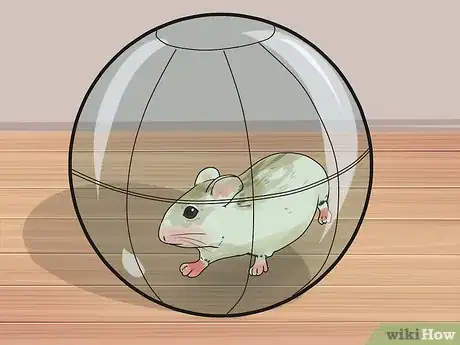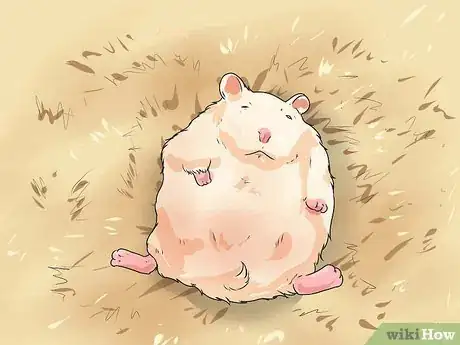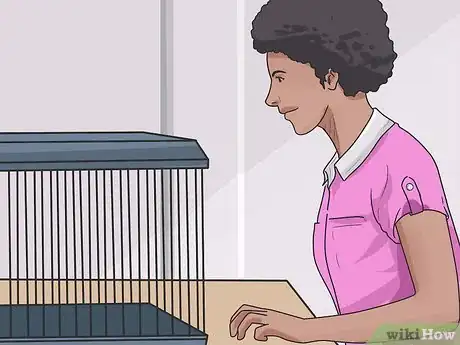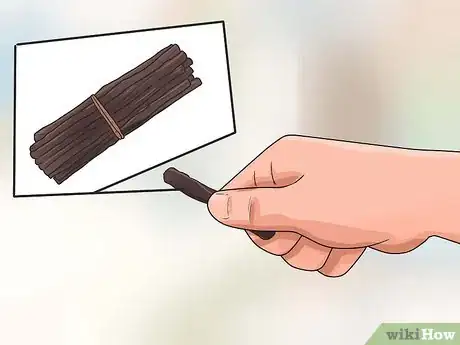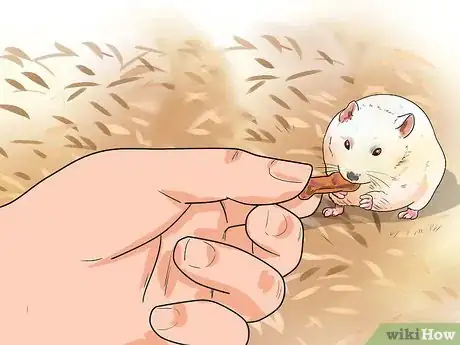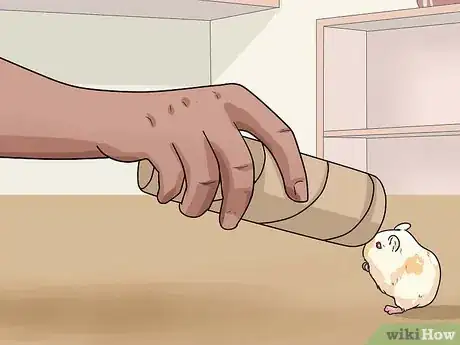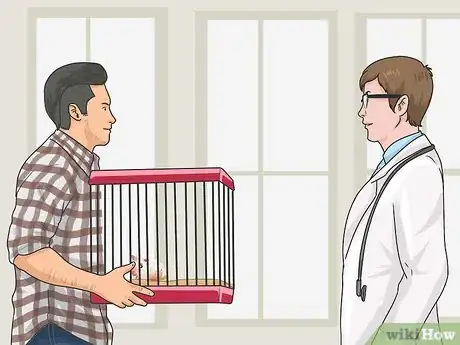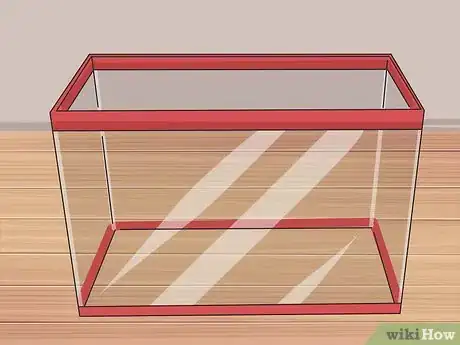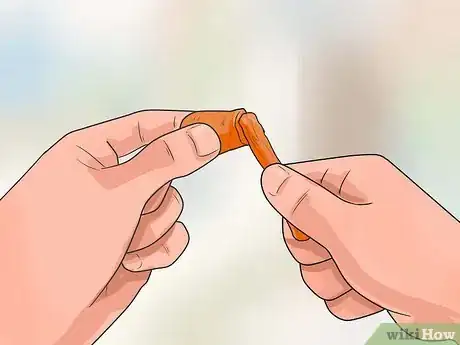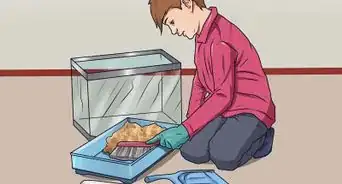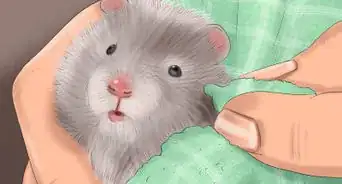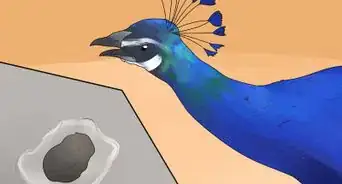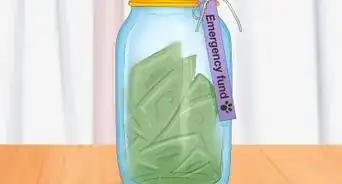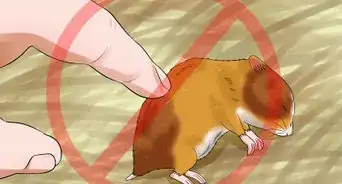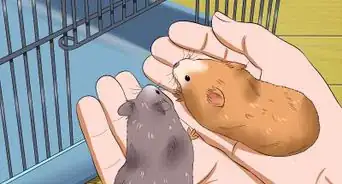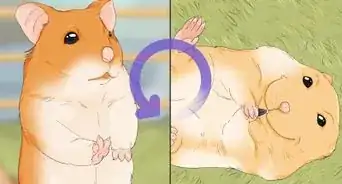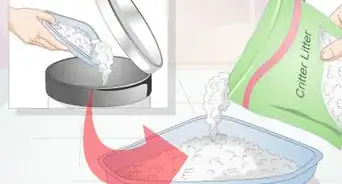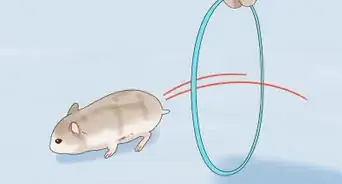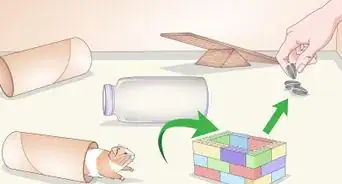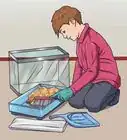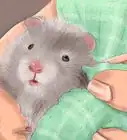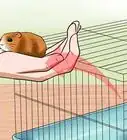This article was co-authored by Pippa Elliott, MRCVS. Dr. Elliott, BVMS, MRCVS is a veterinarian with over 30 years of experience in veterinary surgery and companion animal practice. She graduated from the University of Glasgow in 1987 with a degree in veterinary medicine and surgery. She has worked at the same animal clinic in her hometown for over 20 years.
wikiHow marks an article as reader-approved once it receives enough positive feedback. This article has 11 testimonials from our readers, earning it our reader-approved status.
This article has been viewed 333,224 times.
Hamsters (and many other pets) bite their cages for a variety of reasons. The most common causes of cage biting are boredom, attention-seeking behavior, managing teeth growth, and the simple pleasure of chewing. Aside from being mildly disruptive to have a hamster biting his bars in your room, bar chewing can lead to broken teeth and other painful mouth injuries. Understanding why your hamster bites his cage is the first step toward curbing this undesirable behavior.
Steps
Stopping Boredom and Attention-Seeking Biting
-
1Let your hamster play more. Let him roam around on you, on your bed, or in a hamster-proof area. Exercise may help work out the boredom that your hamster might be feeling.
- Make sure you've hamster-proofed the area in which your hamster will be playing. Remove any electrical cords so he does not chew on them. Keep the area enclosed, either by closing the door to a small room or by setting up "walls" around your hamster's play area.[1]
- Give your hamster a wheel to run on. Hamster wheels are a great way for hamsters to get exercise and work out extra energy. Avoid wire-frame wheels, as these could potentially injure your hamster.[2]
- Use a scoop or a small box, held in front of your hamster, to remove him from his enclosure. Reaching into the cage might make your hamster feel that his space is being invaded.[3]
- Let your hamster crawl around on top of you while you lie on the floor. Hamsters love to explore, and once your hamster has developed a trust in you as his owner, he'll want to climb on and around you.
-
2Let your hamster sleep during the day. Hamsters are nocturnal, which means they sleep during the day and are awake and active at night. Waking your hamster up during the day, whether to play with him or to clean his cage, may cause him irritation. Interrupting his natural sleep schedule could lead to further undesirable behavior.[4]Advertisement
-
3Give your hamster a bigger cage. It's possible that your hamster is bored with his surroundings and longs for more room to play in his enclosure. If this is the case, your pet might benefit from having a bigger cage.
- As a general rule, a dwarf hamster needs at least 450 sq inches of floorspace, and benefit from having even bigger cages. Do not house your hamster with another hamster, as they are not social animals.
Managing Teeth Growth
-
1Give your hamster wood to chew on. Hamsters' teeth continue to grow their whole lives. If your hamster does not have a chew toy, his constant chewing may not be attention-seeking behavior.
- Hamsters need to chew everyday to prevent their teeth from becoming too long, which could cause serious pain and potentially harm your pet.[5]
- Untreated, paint-free, oil-free wood is the best choice for chew toys. Avoid using wood harvested from outdoors, as this wood has not been properly inspected and could harbor harmful parasites or be treated with pesticides.[6]
- Wood from an apple or pear tree is ideal, as these woods do not have any harmful oils and are therefore less likely to pose any threat to your hamster's respiratory or digestive health.
- Never give your hamster pine or cedar wood to chew on. The oils in these woods can be toxic to your hamster.
-
2Try giving your hamster dog treats. A hard biscuit can make an excellent alternative chew toy for hamsters.[7]
- Give hamsters hard treats like dog biscuits about once every week.[8]
- Be sure the dog treats you give your hamster are free of garlic. Garlic is known to cause digestive problems in hamsters.
-
3Give your hamster cardboard. The cardboard tube from a roll of paper towel or toilet paper makes an excellent chew toy for hamsters, and has the additional benefit of providing your hamster with a convenient hiding place.
- Try cutting a small hole in the tube before you give it to your hamster. That may help him see the potential in the tube, and may inspire him to make his own chew holes.
-
4Take your hamster to the vet. A veterinarian can trim your hamster's teeth down to a manageable length, which may be necessary if your hamster has not responded to chew toys.
- Having a vet trim your hamster's teeth is quick and does not cause any harm to your hamster.
- Do not attempt to trim your hamster's teeth on your own, unless your vet has approved this procedure and given you proper instruction in how best to do this.
Stopping Enjoyment Chewing
-
1Try a different cage. If your hamster continues to chew the bars of his cage, and you've ruled out teeth management as the cause, you may want to consider giving him a bigger cage.[9]
-
2Give him alternatives. If your hamster isn't interested in using his wood chew, try rubbing a carrot or apple on the wood. If he still doesn't respond well to his wood chew, try giving him hard-shelled nuts to chew on.
-
3Always get a bigger cage if possible. Most of the time a hamster chewing on bars is a sign of stress or boredom. You can also try to give your hamster more bedding. A hamster needs at least 6 inches of bedding and many hamsters need 10 inches of bedding to even try to burrow. To make your hamster less stressed, make sure there is always a place for your hamster to hide. Since hamsters a prey in the wild, they see open spaces as something dangerous.
Expert Q&A
Did you know you can get expert answers for this article?
Unlock expert answers by supporting wikiHow
-
QuestionI gave my hamster a chew toy, but it doesn't bite it, only the cage! Any tips?
 Pippa Elliott, MRCVSDr. Elliott, BVMS, MRCVS is a veterinarian with over 30 years of experience in veterinary surgery and companion animal practice. She graduated from the University of Glasgow in 1987 with a degree in veterinary medicine and surgery. She has worked at the same animal clinic in her hometown for over 20 years.
Pippa Elliott, MRCVSDr. Elliott, BVMS, MRCVS is a veterinarian with over 30 years of experience in veterinary surgery and companion animal practice. She graduated from the University of Glasgow in 1987 with a degree in veterinary medicine and surgery. She has worked at the same animal clinic in her hometown for over 20 years.
Veterinarian Some biting and chewing can become learned behavior, and this is very difficult to break. Provide more than one toy, and keep changing them around so they remain new and exciting. Provide plenty of objects for the hamster to chew on, such as orchard woods, and hide the food inside a cardboard roll (the inner roll from toilet paper), and plug with ends with hay so the hamster has to work to get the food, chewing the cardboard in the process.
Some biting and chewing can become learned behavior, and this is very difficult to break. Provide more than one toy, and keep changing them around so they remain new and exciting. Provide plenty of objects for the hamster to chew on, such as orchard woods, and hide the food inside a cardboard roll (the inner roll from toilet paper), and plug with ends with hay so the hamster has to work to get the food, chewing the cardboard in the process. -
QuestionWhat sort of wood is safe for hamsters to bite?
 Pippa Elliott, MRCVSDr. Elliott, BVMS, MRCVS is a veterinarian with over 30 years of experience in veterinary surgery and companion animal practice. She graduated from the University of Glasgow in 1987 with a degree in veterinary medicine and surgery. She has worked at the same animal clinic in her hometown for over 20 years.
Pippa Elliott, MRCVSDr. Elliott, BVMS, MRCVS is a veterinarian with over 30 years of experience in veterinary surgery and companion animal practice. She graduated from the University of Glasgow in 1987 with a degree in veterinary medicine and surgery. She has worked at the same animal clinic in her hometown for over 20 years.
Veterinarian As a rule of thumb, 'orchard' woods, those from apple, pear, and plum, (with the exception of cherry trees) are considered safe. Also safe are mulberry, crab-apple, kiwi, hazelnut, grape, and pecan woods. Be wary of pine or cedar, as these contains oils that are toxic. If you have a specific tree in your yard, then it's always best to double-check if it's safe before offering the hamster some to chew.
As a rule of thumb, 'orchard' woods, those from apple, pear, and plum, (with the exception of cherry trees) are considered safe. Also safe are mulberry, crab-apple, kiwi, hazelnut, grape, and pecan woods. Be wary of pine or cedar, as these contains oils that are toxic. If you have a specific tree in your yard, then it's always best to double-check if it's safe before offering the hamster some to chew.
Warnings
- Keep hamsters away from electrical cords.⧼thumbs_response⧽
- Always keep a close on eye on hamsters when you let them out to play.⧼thumbs_response⧽
- Remove any sharp objects and small pieces of plastic that hamsters may eat.⧼thumbs_response⧽
- If your hamster is biting the bars, it could be hazardous. Check the bars every day.⧼thumbs_response⧽
Things You'll Need
- Cardboard boxes
- Paper towel tubes
- Hamster treats
- Lots of paper to wad and shred.
- Chew toys / apple tree branch
- Dog biscuits
References
- ↑ http://www.aspca.org/pet-care/small-pet-care/hamster-care
- ↑ http://vethealingeldoradohills.com/2015/04/01/cameron-park-vet-hamster-care-beginners/
- ↑ http://www.northstarrescue.org/pet-care-information/pet-hamster-care/105-meet-the-hamsters-campbells-dwarf-hamster-profile
- ↑ http://www.aspca.org/pet-care/small-pet-care/hamster-care
- ↑ http://www.aspca.org/pet-care/small-pet-care/hamster-care
- ↑ http://www.aspca.org/pet-care/small-pet-care/hamster-care
- ↑ http://www.humanesociety.org/animals/hamsters/tips/hamster_feeding.html?referrer=https://www.google.com/
- ↑ http://www.humanesociety.org/animals/hamsters/tips/hamster_feeding.html?referrer=https://www.google.com/
- ↑ http://russiandwarfhamster.org/stop-hamster-biting-the-bars/
About This Article
To make dwarf hamsters stop biting the cage, try giving them hard-shelled nuts to chew on. Alternatively, give them a piece of wood, like wood from an apple or pear tree. Additionally, provide your hamsters with dog treats, such as a hard biscuit. You could also give them the cardboard tube from a roll of toilet paper to bite. If none of these techniques stop your hamsters from biting, consider buying a larger cage, since they may be bored with their surroundings and want more room to play. For tips on how to make your own bite deterrent spray, keep reading!
